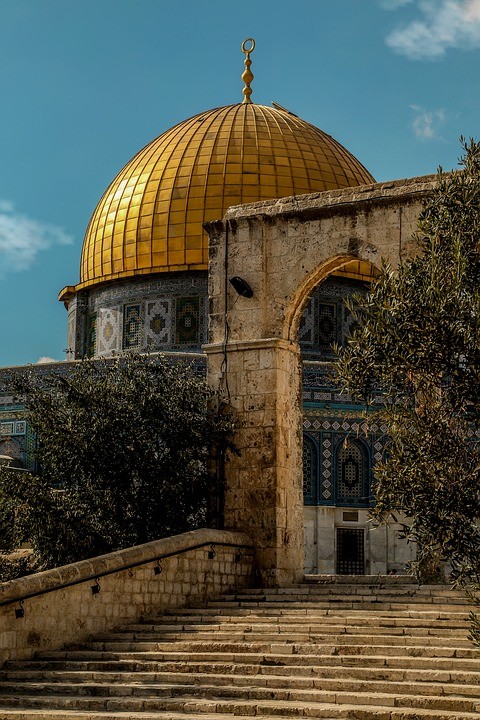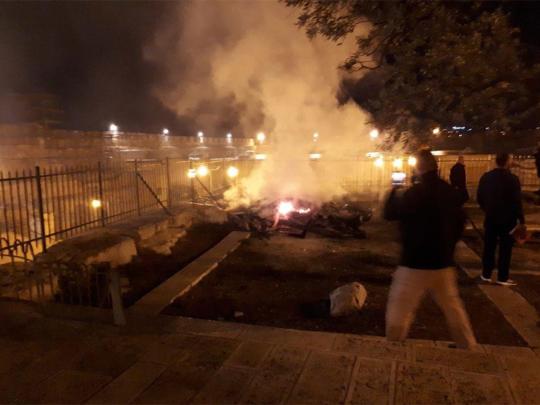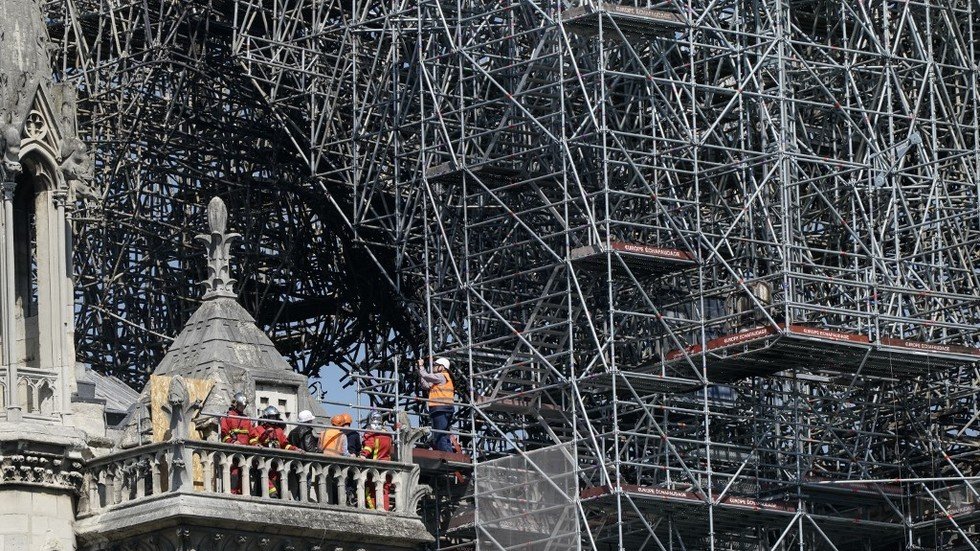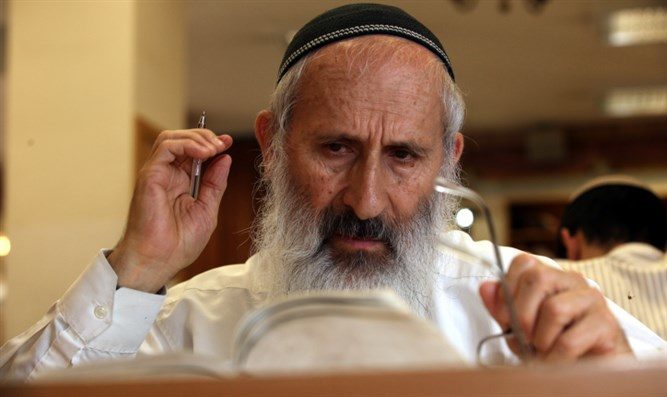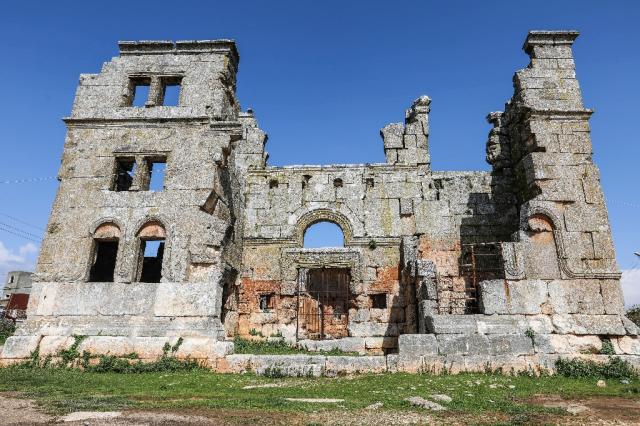A little bit off the beaten path ...
Experts say there are similarities between the 5th century Qalb Lozeh church in northwestern Syria and Notre-Dame cathedral in Paris.
April 19, 2019 - In war-torn Syria, an ancestor of Notre-Dame still stands
In war-torn Syria, an ancestor of Notre-Dame still stands
Qalb Lozeh (Syria) - An arched entrance flanked by two towers, elaborate carvings and a broad-aisled nave: a 5th century limestone church in northwestern Syria is the architectural forerunner of France's famed Notre-Dame cathedral.
Hemmed by the village of Qalb Lozeh (Arabic for Heart of the Almond), the cathedral which goes by the same name is widely hailed as Syria's finest example of Byzantine-era architecture.
And it is believed to have been the source of inspiration for Romanesque and Gothic cathedrals in Europe, including the Paris landmark Notre-Dame.
"It is the earliest known example of the twin tower facade flanking a highly elaborate arched entrance, the precursor to what became known as the Romanesque style," says Middle East cultural expert Diana Darke.
Romanesque architecture evolved into the Gothic style that defines Notre-Dame, she tells AFP.
The layout of the church in northwestern Syria has many similarities with Notre-Dame, she says. "The specific similarities between Notre-Dame and Qalb Lozeh are first and foremost, the twin tower design flanking the elaborate arched portal," says Darke.
Inside Qalb Lozeh, "the similarities are in the pillars dividing the church into three broad aisles -- the nave and side-aisles -- a deliberate echoing of the Holy Trinity, with three sweeping arches resting on broad capitals to spread and distribute the weight which carried the clerestory windows and the original wooden roof over the nave," she adds.
The abandoned church is within a cluster of 40 so-called "Ancient Villages of Northern Syria" which UNESCO has included on its World Heritage List since 2011.
Two years later as fighting ravaged Syria and its cultural heritage the villages were placed on UNESCO's list of endangered sites.
UNESCO says the villages including Qalb Lozeh -- home to pagan temples and ancient churches -- illustrate "the transition from the ancient pagan world of the Roman Empire to Byzantine Christianity".
Crusaders export design - Qalb Lozeh was built by Syrian Christians whose wealth was based on wine and olive oil production, says Darke.
The church was frequented by pilgrims and is thought to have been a key stop on the way to the nearby basilica of Saint Simeon the Stylite.
"Merchants, pilgrims and monks moved constantly between this area and Europe over the centuries," she says. "So it's not surprising that the design ideas found their way gradually back to Europe, even before the crusaders of the 12th century," she adds.
Syrian historian Fayez Kawsara said that crusaders brought Qalb Lozeh's architectural style to Europe in the 12th century.
"Anyone who delves deep in the study of Gothic art and especially Gothic churches will find that this architectural style travelled to Europe (from Syria)" he says, pointing to the cathedral's soaring arches, its detailed sculpting and its squared towers. "The biggest proof of this is... Notre-Dame cathedral," adds Kawsara.
Qalb Lozeh -- which is much smaller in size than the Paris landmark, lies in the jihadist-held region of Idlib.
Children used the abandoned church as a playground and graffiti has been scrawled on the outside and inside walls of the cathedral. Caretakers who guarded the church quickly left after Syria's conflict erupted in 2011.
Since then it has fallen into neglect, says villager Issam Ibrahim. "It was not being protected and as village residents, we took it upon ourselves to protect the site," he says.
Wissam Mohammad, another resident, said the church holds important significance for the local community. "It is not just a pile of old stones. It is a symbol of Syria's culture," says Mohammad.
April 19, 2019 - Robot helped save Notre-Dame Cathedral
Robot helped save Notre-Dame Cathedral
Colossus, a fire-fighting robot, taking part in a drill in 2017. It is said to have lowered temperatures in Notre-Dame's glass-filled nave and saved the lives of French firefighters in the Monday fire. PHOTO: AGENCE FRANCE-PRESSE
PARIS • With a wall of red-orange flames rapidly advancing and Notre-Dame's vast chambers reaching oven-like temperatures, the commander of the Paris fire brigade made a painful choice on Monday evening. He told his firefighters to retreat.
Losing a beloved medieval relic would be devastating, of course, but losing human lives in a hopeless effort to save the building would be even worse. But
Commander Jean-Claude Gallet had a backup plan: Colossus, a 500kg tank-like robot with the ability to venture into danger zones where conditions would quickly kill a person. Using a motorized water cannon capable of firing 2,500 litres per minute, Colossus took aim at the stone walls of the ancient cathedral and began spraying.
In an interview with the Times of London, Commander Gallet credited the fire-fighting robot with lowering temperatures inside the glass-filled nave and saving the lives of its human counterparts as an even greater disaster loomed.
"Time was against us, the wind was against us, and we had to get the upper hand," Lieutenant-Colonel Gabriel Plus, a spokesman for the Paris fire brigade, told the paper.
"The priority we set was to save the two belfries. Imagine if the timber of the belfries had been weakened and the bells had collapsed. That was really our fear. In the beginning, it was not impossible to imagine that the cathedral structure could collapse," he said.
Shark Robotics, the French company that created the machine, says the Colossus - which is 76cm wide and 160cm long - can carry 544kg and be operated from over 300m away.
Controlled using a joystick, the machine is waterproof, fireproof and can even withstand thermal radiation, according to the company.
It can crawl up stairs. The machine's lithium ion batteries can last for up to eight hours, and the robot can be equipped with cameras, sensors and a smoke-extracting fan.
The machine's heroic role in the
Notre-Dame fire may be remembered as the beginning of a new era of robotic firefighting.
Colossus is far from the only robotic firefighter available for action.
In China, video footage has emerged of firefighting robots taking part in drills alongside human firefighters.
Apr 18, 2019 - As rich lavish cash on Notre-Dame, many ask: What about the needy?
As rich lavish cash on Notre-Dame, many ask: What about the needy?
The Notre-Dame Cathedral from a bank of the river Seine, in the aftermath of a fire that devastated the place of worship, on April 17, 2019.PHOTO: AFP
The firestorm began when Mr Jean-Jacques Aillagon, a former culture minister and now adviser to Mr Pinault's father, went on Twitter after Mr Francois-Henri Pinault announced his gift on Tuesday to suggest that corporate contributions to Notre-Dame's restoration be given a 90 per cent tax deduction, rather than the 60 per cent that corporations normally get for charitable contributions. 
Mr Francois-Henri Pinault, France's second-richest man, put up an eye-popping €100 million (S$152 million) to rebuild Notre-Dame, just as firefighters were
dousing the last flames at the cathedral on Tuesday morning (April 16). Not to be outdone, Mr Bernard Arnault, France's wealthiest scion and a fierce rival to Mr Pinault and to his father Francois Pinault, upped the ante with a €200 million gift a few hours later.
By Wednesday, the government had welcomed some €850 million - more than US$960 million (S$1.3 billion) -
offered in the patriotic name of salvaging the cultural treasure, as money from wealthy French families, French companies and international corporations poured in. But the spectacle of billionaires trying to one-up one another quickly intensified resentments over inequality that have flared during the yellow vest movement, just as President Emmanuel Macron was looking to transform the calamity into a new era of national unity. There were accusations that the wildly rich were trying to wash their reputations during a time of national tragedy.
"Can you imagine, 100 million, 200 million in one click!" said Mr Philippe Martinez, head of the militant CGT labour union. "It really shows the inequalities in this country... If they're able to give dozens of millions to rebuild Notre-Dame, they should stop telling us that there is no money to pay for social inequalities."
Mr Ollivier Pourriol, a French philosopher and novelist, summed up the sentiment more drolly. "Victor Hugo thanks all the generous donors ready to save Notre-Dame and proposes that they do the same thing with Les Miserables," he wrote on Twitter, referring to another one of Hugo's famous novels, about the lives of the poor.
Ms Manon Aubry, a senior figure in France Insoumise, the main radical left party, called the funding an "exercise in public relations".
She said the donors' list "looks like the rankings of companies and people located in tax havens". She added: "I want to tell them: Start by paying your taxes. That will add to the state culture budget."
The bickering was about as far as possible to imagine from the image of a united France the President painted when he gave a national address on Tuesday. Mr Macron said "it is up to us to transform this catastrophe" into a moment to become "better than what we are".
The firestorm began when Mr Jean-Jacques Aillagon, a former culture minister and now adviser to Mr Pinault's father, went on Twitter after Mr Francois-Henri Pinault announced his gift on Tuesday to suggest that corporate contributions to Notre-Dame's restoration be given a 90 per cent tax deduction, rather than the 60 per cent that corporations normally get for charitable contributions. "That's when the whole thing exploded," said Mr Pierre Haski, a commentator for France-Inter, the public radio station. "That produced outrage, that this act of generosity turns into fiscal advantage."
The reaction was so intense that Mr. Aillagon went on the radio on Wednesday morning to retract his suggestion. The Pinault family then announced that they would seek no tax deduction at all for the gift. "It was very revealing about the sensitivity of the whole issue," Mr Haski said, coming in the midst of a great national debate about the yellow vests and their protests against inequality and fiscal privileges.
In general, many are relieved that Notre-Dame still stands, and if there is now €1 billion to reconstruct it, without calling too deeply on an already stretched national budget, that may be enough. But taxes have been one of the pressing issues in the yellow vest movement, and the one that Mr Macron has had most trouble diffusing.
The protests that began in autumn were originally over a gasoline tax, but morphed into a larger collective outcry over declining living standards that many average French people complained were rooted in high taxes, while the upper-middle classes in the big cities, let alone the rich, were doing just fine.
The protesters have lashed out at Mr Macron for favoring the very rich by eliminating a wealth tax, among other inducements as part of his plan to stimulate the economy. While he has since announced a series of modest tax cuts to help people struggling to make ends meet, he has refused to reinstate the wealth tax, a symbolic slap in the face of the protesters that redoubled their anger.
The companies contributing are among the largest in France, and account for tens of thousands of jobs at home and abroad in the luxury, energy and construction industries. But for many, they are also symbols of an untouchable class of super-rich who keep getting richer, thanks to a host of fiscal advantages.
The companies contributing are among the largest in France, and account for tens of thousands of jobs at home and abroad in the luxury, energy and construction industries. But for many, they are also symbols of an untouchable class of super-rich who keep getting richer, thanks to a host of fiscal advantages.
These billionaires want to pass for heroes," Ms Esther Benbassa, a senator with the Green party, said on Twitter. "They would do better to renounce tax evasion and fiscal optimization."
April 19, 2019 - Scammers preying on Notre-Dame donors, France warns
Scammers preying on Notre-Dame donors, France warns
Any phone or email appeals are fake, French Heritage Foundation warns.
Fraudsters are taking advantage of the Notre-Dame fire to fool donors into handing over cash believing they are helping to rebuild the gutted Paris cathedral, officials have warned.
The French Heritage Foundation, which has so far collected more than 13 million euros ($14.5 million) from individual donors to help restore the gothic landmark, said any phone or email appeals were fake.
“A number of scams have been flagged to us both in France and abroad,” the foundation said Wednesday, insisting it issues no appeals by phone, mail or email for donations. “All of these initiatives are fraudulent.”
The foundation is accepting donations through its website (don.fondation-patrimoine.org), its Facebook page, PayPal, a Paris metro station and by SMS for those in France.
Culture Minister Franck Riester on Tuesday warned people to be vigilant of websites claiming to support the reconstruction of Notre-Dame, which suffered heavy damage in Monday’s blaze.

